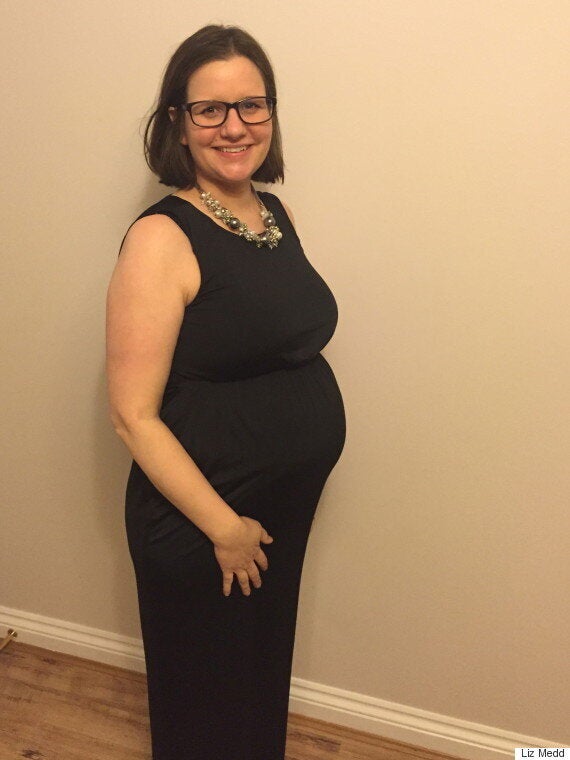
Two women who struggled to get pregnant discovered they were suffering from a condition their GPs had never heard of.
"The hardest part for me was the point when nobody believed there was anything wrong with me," said Liz Medd, 37, a radiographer, from Sunderland.
"I’d seen every GP in the surgery, I’d seen the specialist at the local hospital. I felt like I'd gone down every avenue.
"In my medical notes it states how many times I told my GP I thought I had Asherman’s syndrome, and after every time they wrote 'long chat, patient reassured'.
"The issue is that it isn’t a condition doctors come across very often. It’s very low down on the list of things that could be stopping a woman having periods."
Asherman's Syndrome is the name given to scar tissue in the uterus (sometimes called uterus adhesions), which can prevent women getting pregnant or make them suffer recurrent miscarriages.

Liz Medd struggled to get a diagnosis for the cause of her infertility
The most common cause of Asherman's Syndrome is injury to the uterus sustained during surgery, such as dilatation and curettage (D&C) following a miscarriage or birth.
It can also be caused by injury during an abortion, caesarean section or from an infection of the uterus called Endometritis.
Dr George Ndkwe, medical director of the Zita West fertility clinic, explained to HuffPost UK Parents how uterus scarring can cause problems for women who want to have a baby.
"Inside the uterus is like a pocket, with a front and back wall flat against each other," he explained. "This pocket is lined with tissue called the endometrium.
"During menstruation this endometrium is shed and women bleed. When a woman becomes pregnant the embryo implants in this endometrium the lining.
"An injury or infection of the endometrium may damage the lining and cause adhesions and scar tissue between the inner walls of the uterus.
"This scarring can be mild in thin bands of scar tissue or it can be more severe and form very thick bands making it difficult for an embryo to implant. In very severe cases an obstruction of the uterus can occur."
Medd developed Asherman's syndrome after she underwent surgery following a miscarriage.
"I discovered I had miscarried at the 12 week scan," she said. "The baby had probably died at around eight weeks.
"I was told I could wait it out and see if I would miscarry naturally, but I didn’t go for that because I was already a few weeks down the line of losing the baby and my body hadn’t clicked.
"Instead I went for medical management of the miscarriage, but two weeks later a pregnancy test showed I was still pregnant, which meant that although I had miscarried there was some placental tissue and possibly some fetal tissue left.
"So the doctor said they had to operate to remove the 'retained products of conception'.
"I had what they call an 'evacuation of retained products of conception'. They opened my cervix and vacuumed what was left in the womb.
"So I had that and I was discharged and told my periods should come back in four to six weeks.
"But my periods didn't come back."
Lack of periods following a surgical procedure involving the uterus is a common symptom of Asherman's.
"One of the tell tale signs is if somebody who has a regular cycle, has an operation in the uterus and all of a sudden they don’t have any periods or their periods become infrequent," said Ndkwe.
But not everyone with Asherman's will experience a change in their menstrual cycle.
"A lot of women who have Asherman’s syndrome have no real problems at all," said Ndkwe.
"It only becomes a problem if it causes them to struggle to conceive or recurrent miscarriages."
SEE ALSO:
Secondary Infertility: The Silent Sadness
This Test Could Increase A Woman's Chance Of Getting Pregnant Through IVF By 80%
Another woman who struggled to concieve because of uterus adhesions is 29-year-old Amanda McConnell, an assistant engineer from Glasgow.
Her problems began after the birth of her son Euan in August 2012.
"I had a great pregnancy, no problems at all," said McConnell.
"But I needed to have an emergency caesarean section and there were a few complications, which meant I lost a lot of blood. So two weeks after Euan was born I was back in hospital and I had to have a D&C.
"After that my periods didn't return. The doctors kept saying, 'it’s fine, your body’s just taking time to get back to normal.'
"Euan was about 6 months old when I was on the internet searching, as you do, and I eventually stumbled across the International Asherman’s Association.
"I read all the descriptions and I ticked all the boxes. I went back to my GP and told her about Asherman’s. She hadn’t heard of it either, but she agreed to refer me to a gynecologist, who finally diagnosed me about eight months after I'd given birth."

Amanda McConnell with her husband Martyn and their children Euan, three and nine-month-old Eilidh, the baby she feared she may never have
Medd also struggled to get a diagnosis.
"Five months after I'd had the surgical management I was referred to a gynaecologist," she said.
"It was getting close to what would have been my baby's due date and I still hadn't got a diagnosis.
"It was a very difficult time emotionally. I felt a bit like I was still miscarrying because I couldn’t even have a period, so I couldn't try for another baby.
"The gynaecologist sent me for an ultrasound scan which they said showed I had a bit of a thin womb lining, but didn’t show any abnormalities.
"And then I continued to go back and forth to my GP, who tried different things to restart my periods, such as putting me on a contraceptive pill and giving me progesterone, but nothing worked.
"I was beginning to feel like I was being fobbed off, so 14 months after my medical management of a miscarriage I asked to be referred to a fertility specialist.
"The specialist looked at my hysterology and told me that during the surgery to remove the retained products of conception they’d actually gone too deep and they’d managed not only to remove some of my endometrium, but they'd also removed some of the muscle beneath it.
"It was there in my notes, but until that point nobody had picked this up.
"It was then the specialist told me he thought I had Asherman's."
The reason many GPs, like Medd and McConnell's, haven't come across Asherman's is because it is quite a rare condition.
"It’s not very common," says Dr Anabel Salazar from IVI fertility clinic.
"It affects less than 5% of people who come to infertility clinics, which means among the general population it is even less common."
Asherman's is diagnosed through a procedure known as a hysteroscopy, in which a small tube with a telescope or a camera at the end (a hysteroscope) is inserted through the cervix into the womb.
For both McConnell and Medd a hysteroscopy confirmed they had Asherman's, and in Medd's case it was very severe.
"When the fertility doctor put the camera into my womb he actually found that I had quite a dense wall of adhesions,"she said.
"He explained to me that I had scarring about 2cm into my womb.
"The endometrium is what usually stops the walls of your womb from sticking together and because mine was so damaged the two walls of my womb were stuck together from about 2cm in, so when he put the camera in it looked like there was a wall blocking my womb."
Getting a diagnosis came as a relief to both women, as they finally knew what was causing their problems, but it came with the knowledge that without treatment it was highly unlikely they'd be able to get pregnant.
"I felt lucky because I had Euan, but I'd always wanted more than one child, so it was quite consuming," said McConnell.
"I tried to stay positive, but it’s difficult when you think there’s a chance you might never be pregnant again."
SEE ALSO:
Men Speak Out About Infertility: 'A Father And Kid Playing Together Brought Me To Tears'
Sex Education Book Teaches Kids That Not All Babies Are Naturally Conceived
As well as being used to diagnose Asherman's syndrome, hysteroscopys are also the most common method used to treat the scarring.
The hysteroscope is inserted into the uterus along with microscissors to remove the adhesions.
Following the operation the patient will be given a course of hormone treatment and fitted with a uterine balloon or a coil (like the ones used for contraception) to keep the two walls of the uterus apart while they heal and prevent new adhesions forming.
In many cases women have to undergo the operation twice before all their adhesions are removed.
Hysteroscopy for Asherman’s is a difficult operation that should only be carried out by a surgeon who specialisies in the procedure, as there is a risk of making the scarring worse.
If successful the operation can restore fertility, but sadly this is not always the case.
"If there were mild to moderate adhesions usually, with surgery, 70 to 80% of women will have a return to normal menstrual function and the chance of having a successful pregnancy," explained Ndkwe.
"But if there are severe adhesions, with extensive destruction of the uterus lining , then the chance of a successful pregnancy will only be between 20 to 40% after treatment."
According to Dr Salazar a new treatment option could be on the horizon.
"Recently there have been trials of techniques involving stem cell treatment," she said.
"It seems that bone marrow stem cells can reach the damage in the endometrium and try to help in the restoration – but this is something that is still in the experimental stage."
McConnell conceived her second child just 10 months after surgery, and now has a nine-month-old daughter called Eilidh.
"There are risks with post Ashermans pregnancies," said McConnell "The most common is placenta accreta [where your placenta grows in the lining of your womb and into or through the womb muscle]. I had this with my daughter.
"It resulted in a large blood loss but it was easily managed as the doctors were prepared for it, and other than that I had another healthy pregnancy and gave birth to my daughter in April 2015.
"I'm very grateful to be where I am today, that’s for sure."
Medd had to have a second operation because of the extent of her scarring, and her doctors were concerned she may have a further problem - it looked like her fallopian tubes might be blocked.
But at a follow up appointment with her NHS doctor she was able to tell the medical team some very good news.
"I had a test to see if my fallopian tubes were blocked, and when I went to see the doctor to discuss the results of that test, I was actually pregnant by that point," she said.

Liz Medd worried she wouldn't be able to get pregnant when she was diagnosed with Asherman's syndrome
"There are some risks to pregnancy after Asherman’s and I bled in the first two weeks of this pregnancy," adds Medd.
"But the medical teams were very good and they sent me along to the early pregnancy unit, and although it was a stressful time because I was very worried I would have another miscarriage, they’ve been monitoring me very closely and now I'm eight months pregnant, with a baby girl.
"She’s due in February. Potentially a leap day baby. We’ll see, she’ll come when she wants to come."
Both Medd and McConnell found an invaluable support network through the International Asherman's Association, which as well as being a source of information on the condition also runs support groups on Facebook and Yahoo.
"Having ladies who you can talk to who have been there, is a major help," said Medd.
"It's great to be able to talk to women at every stage of the process: From those who just suspect they have Asherman's but haven't been diagnosed yet, to those who have had multiple surgeries.
"They are very supportive and everybody’s willing to offer advice."
McConnell adds: "The online groups are an absolute lifesaver, because it can feel quite lonely, especially as most people have never heard of Asherman's, - none of my friends or family had ever heard of it.
"And when the GP hadn’t heard of it that made me very anxious, so having people to talk about it, who knew what I was going through from start to finish, really helped to keep me positive. I can't thank the girls enough for giving me hope."